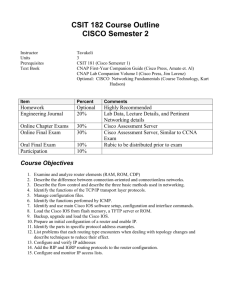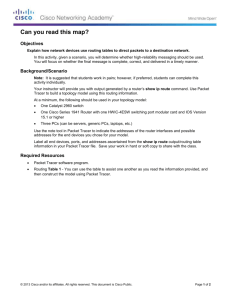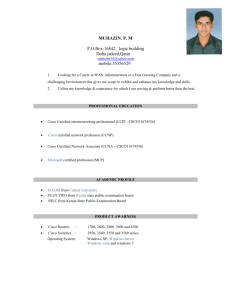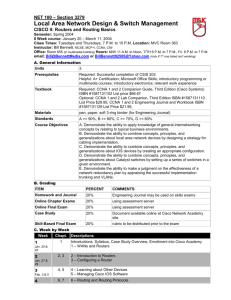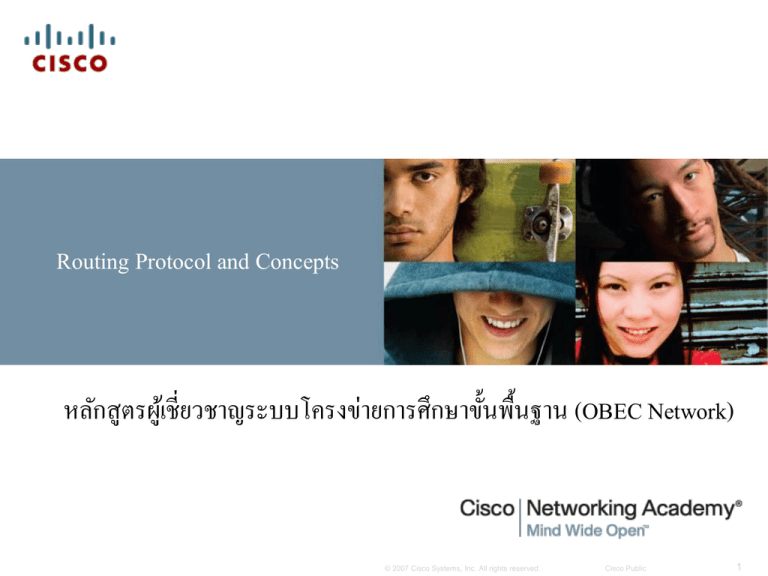
Routing Protocol and Concepts
หลักสู ตรผูเ้ ชี่ยวชาญระบบโครงข่ายการศึกษาขั้นพื้นฐาน (OBEC Network)
© 2007 Cisco Systems, Inc. All rights reserved.
Cisco Public
1
Routing Protocol and Concepts
© 2007 Cisco Systems, Inc. All rights reserved.
Cisco Public
2
Routing Protocol and Concepts
ลักษณะการส่ ง Packet ใน IP Network จะส่ งทีละ Hop จาก Network
หนึ่ง ไปยังอีก Network หนึ่ง
Router จะทาหน้าที่ดงั กล่าว เนื่องจาก Router เป็ นตัวเชื่อมระหว่าง
Network
การส่ งจะดูที่ส่วน Prefix ของ IP Address ดังนั้น Router จะต้อง Run
IP Protocol คือทางานในระดับ Layer 3
ที่ Router จะมีตารางชื่อ Routing Table ที่กาหนด IP Address ของ
Next Hop
© 2007 Cisco Systems, Inc. All rights reserved.
Cisco Public
3
Routing Protocol and Concepts
Static Routing : หมายถึงตาราง Routing Table ของ Router แต่ละตัว
จะไม่เปลี่ยน ปกติตารางนี้จะถูกกาหนดจาก Network Administration
คือตารางนี้จะได้จากการทา Configuration ของ Router
Dynamic Routing : หมายถึงตาราง Routing Table สามารถเปลี่ยนได้
ตามสภาวะความคับคัง่ ของ Network ขณะนั้นหรื อจากปัจจัยอื่นๆ
โดยมันจะมีการ Update ตลอดเวลา
© 2007 Cisco Systems, Inc. All rights reserved.
Cisco Public
4
Routing Protocol and Concepts
หน้าที่หลักของ router
• การพิจารณาคัดเลือกเส้นทางในการส่ งผ่านข้อมูลไปยัง
เครื อข่ายคอมพิวเตอร์อื่น ๆ (Internetworking Device) การ
ส่ งผ่านข้อมูลของ Router จะใช้โปรโตคอล IP โดยทางานอยู่
บนระดับชั้นที่ 3 ของแบบจาลอง OSI Model
• Routers generally have 2 connections:
-WAN connection (Connection to ISP)
-LAN connection
© 2007 Cisco Systems, Inc. All rights reserved.
Cisco Public
5
Routing Protocol and Concepts
Data is sent in form of packets between 2 end devices
Routers are used to direct packet to its destination
© 2007 Cisco Systems, Inc. All rights reserved.
Cisco Public
6
Routing Protocol and Concepts
Routers examine a packet’s destination IP address and
determine the best path by enlisting the aid of a routing
table
© 2007 Cisco Systems, Inc. All rights reserved.
Cisco Public
7
Routing Protocol and Concepts
ส่ วนประกอบของ router และ ฟังก์ชนั่ การทางาน
• CPU
• Random access memory (RAM)
• Read-only memory (ROM)
• Non-volatile RAM (NVRAM)
• Flash memory
• Interfaces
• -Ethernet / fast Ethernet interfaces
• -Serial interfaces
• -Management interfaces
© 2007 Cisco Systems, Inc. All rights reserved.
Cisco Public
8
Routing Protocol and Concepts
Router components
© 2007 Cisco Systems, Inc. All rights reserved.
Cisco Public
9
Routing Protocol and Concepts
กระบวนการทางานของ router
• Test router hardware
• Power-On Self Test
(POST)
• Execute bootstrap
loader
• Locate & load Cisco IOS
software
• -Locate IOS
• -Load IOS
• Locate & load startup
configuration file or enter
setup mode
• -Bootstrap program
looks for configuration
file
© 2007 Cisco Systems, Inc. All rights reserved.
Cisco Public
10
Routing Protocol and Concepts
การตรวจสอบข้อมูลของตัว router
-The show version command is used to view information about
the router during the bootup process. Information includes:
• Platform model number
• Image name & IOS version
• Bootstrap version stored in ROM
• Image file name & where it was loaded from
• Number & type of interfaces
• Amount of NVRAM
• Amount of flash
• Configuration register
© 2007 Cisco Systems, Inc. All rights reserved.
Cisco Public
11
Routing Protocol and Concepts
© 2007 Cisco Systems, Inc. All rights reserved.
Cisco Public
12
Routing Protocol and Concepts
• Router Interface is a physical connector that enables a
router to send or receive packets
• Each interface connects to a separate network
• Consist of socket or jack found on the outside of a router
• Types of router interfaces:
-Ethernet
-Fastethernet
-Serial
-DSL
-ISDN
-Cable
© 2007 Cisco Systems, Inc. All rights reserved.
Cisco Public
13
Routing Protocol and Concepts
Two major groups of Router Interfaces
LAN Interfaces:
Are used to connect router to LAN
network
Has a layer 2 MAC address
Can be assigned a Layer 3 IP
address
Usually consist of an RJ-45 jack
WAN Interfaces
Are used to connect routers to external networks that
interconnect LANs.
Depending on the WAN technology, a layer 2 address
may be used.
Uses a layer 3 IP address
© 2007 Cisco Systems, Inc. All rights reserved.
Cisco Public
14
Routing Protocol and Concepts
Routers and the Network Layer
Routers use destination IP address to forward packets
The path a packet takes is determined after a router
consults information in the routing table.
After router determines the best path
Packet is encapsulated into a frame
Frame is then placed on network medium in form of Bits
© 2007 Cisco Systems, Inc. All rights reserved.
Cisco Public
15
Routing Protocol and Concepts
Routers Operate at Layers 1, 2 & 3
Router receives a stream of encoded bits
Bits are decoded and passed to layer 2
Router de-encapsulates the frame
Remaining packet passed up to layer 3
-Routing decision made at this layer by examining
destination IP address
Packet is then re-encapsulated & sent out outbound interface
© 2007 Cisco Systems, Inc. All rights reserved.
Cisco Public
16
Static Routing
หลักสู ตรผูเ้ ชี่ยวชาญระบบโครงข่ายการศึกษาขั้นพื้นฐาน (OBEC Network)
© 2007 Cisco Systems, Inc. All rights reserved.
Cisco Public
17
General Role of the Router
Functions of a Router
Best Path Selections
Forwarding packets to destination
Introducing the Topology
3 1800 series routers connected via WAN links
Each router connected to a LAN represented by a switch and a PC
© 2007 Cisco Systems, Inc. All rights reserved.
Cisco Public
18
General Role of the Router
Connections of a Router for WAN
-A router has a DB-60 port that can support 5 different cabling
standards
Connections of a Router for Ethernet
-2 types of connectors can be used: Straight through and Cross-
over
Straight through used to connect:
-Switch-to-Router, Switch-to-PC, Router-to-Server, Hub-toPC, Hub-to-Server
Cross-over used to connect:
-Switch-to-Switch, PC-to-PC, Switch-to-Hub, Hub-to-Hub,
Router-to-Router
© 2007 Cisco Systems, Inc. All rights reserved.
Cisco Public
19
Interfaces
Examining Router Interfaces
-Show IP router command – used to view routing table
-Show Interfaces command – used to show status of an
interface
-Show IP Interface brief command – used to show a portion of
the interface information
-Show running-config command – used to show configuration
file in RAM
© 2007 Cisco Systems, Inc. All rights reserved.
Cisco Public
20
Interfaces
Configuring an Ethernet interface
-By default all serial and Ethernet interfaces are down
-To enable an interface use the No Shutdown command
© 2007 Cisco Systems, Inc. All rights reserved.
Cisco Public
21
Interfaces
Verifying Ethernet interface
-Show interfaces for fastEthernet 0/0 – command used to show
status of fast Ethernet
port
-Show ip interface brief
-Show running-config
Ethernet interfaces participate in ARP
© 2007 Cisco Systems, Inc. All rights reserved.
Cisco Public
22
Interfaces
Configuring a Serial interface
-Enter interface configuration mode
-Enter in the ip address and subnet mask
-Enter in the no shutdown command
Example:
-R1(config)#interface serial 0/0
-R1(config-if)#ip address 172.16.2.1 255.255.255.0
-R1(config-if)#no shutdown
© 2007 Cisco Systems, Inc. All rights reserved.
Cisco Public
23
Interfaces
Examining Router Interfaces
-Physically connecting a WAN Interface.
-A WAN Physical Layer connection has sides:
Data Circuit-terminating Equipment (DCE) – This is the
service provider. CSU/DSU is a DCE device.
Data Terminal Equipment (DTE) – Typically the router is the
DTE device.
© 2007 Cisco Systems, Inc. All rights reserved.
Cisco Public
24
Interfaces
Configuring serial links in a lab environment
One side of a serial connection must be considered a DCE
This requires placing a clocking signal – use the clock rate
command.
Example:
-R1(config)#interface serial 0/0
-R1(config-if)#clockrate 64000
Serial Interfaces require a clock signal to control the timing of
the communcations.
© 2007 Cisco Systems, Inc. All rights reserved.
Cisco Public
25
Routing Table and CDP Protocol
Purpose of the debug ip routing command
Allows you to view changes that the router performs when
adding or removing routes
Example:
-R2#debug ip routing
-IP routing debugging is on
© 2007 Cisco Systems, Inc. All rights reserved.
Cisco Public
26
Routing Table and CDP Protocol
To configure an Ethernet interface
Example:
-R2(config)#interface fastethernet 0/0
-R2(config-if)#ip address 172.16.1.1 255.255.255.0
-R2(config-if)#no shutdown
© 2007 Cisco Systems, Inc. All rights reserved.
Cisco Public
27
Routing Table and CDP Protocol
When a router only has its interfaces configured & no
other routing protocols are configured then:
-The routing table contains only the directly connected networks
-Only devices on the directly connected networks are reachable
© 2007 Cisco Systems, Inc. All rights reserved.
Cisco Public
28
Routing Table and CDP Protocol
© 2007 Cisco Systems, Inc. All rights reserved.
Cisco Public
29
Routing Table and CDP Protocol
Checking each
route in turn
The ping
command is
used to check
end to end
connectivity
© 2007 Cisco Systems, Inc. All rights reserved.
Cisco Public
30
Routing Table and CDP Protocol
Purpose of CDP
A layer 2 cisco proprietary tool used to gather information about
other directly connected Cisco devices.
Concept of neighbors
-2 types of neighbors
Layer 3 neighbors
Layer 2 neighbors
© 2007 Cisco Systems, Inc. All rights reserved.
Cisco Public
31
Routing Table and CDP Protocol
CDP show commands
Show cdp neighbors command
-Displays the following information:
Neighbor device ID
Local interface
Holdtime value, in seconds
Neighbor device capability code
Neighbor hardware platform
Neighbor remote port ID
Show cdp neighbors detail command
-Useful in determining if an IP address configuration error
© 2007 Cisco Systems, Inc. All rights reserved.
Cisco Public
32
Routing Table and CDP Protocol
Disabling CDP
To disable CDP globally use the following command
Router(config)#no cdp run
© 2007 Cisco Systems, Inc. All rights reserved.
Cisco Public
33
Static Routes with Exit Interfaces
Purpose of a static route
A manually configured route used when routing from a network
to a stub network
© 2007 Cisco Systems, Inc. All rights reserved.
Cisco Public
34
Static Routes with Exit Interfaces
IP route command
To configure a static route use the following command: ip route
Example:
-Router(config)# ip route network-address subnet-mask {ipaddress | exit-interface }
© 2007 Cisco Systems, Inc. All rights reserved.
Cisco Public
35
Static Routes with Exit Interfaces
Dissecting static route syntax
ip route - Static route command
172.16.1.0 – Destination network address
255.255.255.0 - Subnet mask of destination network
172.16.2.2 - Serial 0/0/0 interface IP address on R2, which is
the "next-hop" to this network
© 2007 Cisco Systems, Inc. All rights reserved.
Cisco Public
36
Static Routes with Exit Interfaces
Configuring routes to 2 or more remote networks
Use the following commands for R1
-R1(config)#ip route 192.168.1.0 255.255.255.0 172.16.2.2
-R1(config)#ip route 192.168.2.0 255.255.255.0 172.16.2.2
© 2007 Cisco Systems, Inc. All rights reserved.
Cisco Public
37
Static Routes with Exit Interfaces
Zinin’s 3 routing principles
Principle 1: "Every router makes its decision alone, based on
the information it has in its own routing table.“
Principle 2: "The fact that one router has certain information in
its routing table does not mean that other routers have the same
information.“
Principle 3: "Routing information about a path from one
network to another does not provide routing information about
the reverse, or return path."
© 2007 Cisco Systems, Inc. All rights reserved.
Cisco Public
38
Static Routes with Exit Interfaces
Using Zinin’s 3 routing principles, how would you
answer the following?
-Would packets from PC1 reach their destination?
Yes, packets destined for 172.16.1.0/24 and 192.168.1.0/24
networks would reach their destination.
-Does this mean that any packets from these networks destined
for 172.16.3.0/24 network will reach their destination?
No, because neither R2 nor R3 router has a route to the
172.16.3.0/24 network.
© 2007 Cisco Systems, Inc. All rights reserved.
Cisco Public
39
Static Routes with Exit Interfaces
Modifying Static routes
Existing static routes cannot be modified. The old static route
must be deleted by placing no in front of the ip route
Example:
-no ip route 192.168.2.0 255.255.255.0 172.16.2.2
A new static route must be rewritten in the configuration
© 2007 Cisco Systems, Inc. All rights reserved.
Cisco Public
40
Static Routes with Exit Interfaces
Verifying the Static Route Configuration
-Use the following commands
Step 1 show running-config
Step 2 verify static route has been entered correctly
Step 3 show ip route
Step 4 verify route was configured in routing table
Step 5 issue ping command to verify packets can reach
destination and that Return path is working
© 2007 Cisco Systems, Inc. All rights reserved.
Cisco Public
41
Static Routes with Exit Interfaces
Ethernet interfaces and ARP.
– If a static route is configured on an Ethernet link
-If the packet is sent to the next-hop router then…
the destination MAC address will be the
address of the next hop’s Ethernet interface
This is found by the router consulting the
ARP table.
If an entry isn’t found then an ARP
request will be sent out
© 2007 Cisco Systems, Inc. All rights reserved.
Cisco Public
42
Summary and Default Route
Summarizing routes reduces the size of the routing
table.
Route summarization is the process of combining a
number of static routes into a single static route.
© 2007 Cisco Systems, Inc. All rights reserved.
Cisco Public
43
Summary and Default Route
Configuring a summary route
Step 1: Delete the current static route
Step 2: Configure the summary static route
Step 3: Verify the new static route
© 2007 Cisco Systems, Inc. All rights reserved.
Cisco Public
44
Summary and Default Route
Default Static Route
This is a route that will match all packets. Stub routers that
have a number of static routes all exiting the same interface are
good candidates for a default route.
-Like route summarization this will help reduce the size of the
routing table
Configuring a default static route
Similar to configuring a static route. Except that destination IP
address and subnet mask are all zeros
Example:
-Router(config)#ip route 0.0.0.0 0.0.0.0 [exit-interface | ipaddress ]
© 2007 Cisco Systems, Inc. All rights reserved.
Cisco Public
45
Summary and Default Route
Static routes and subnet masks
The routing table lookup process will use the most specific
match when comparing destination IP address and subnet
mask
Default static routes and subnet masks
Since the subnet mask used on a default static route is 0.0.0.0
all packets will match.
© 2007 Cisco Systems, Inc. All rights reserved.
Cisco Public
46
Summary
ข้อดีของ Static Routing คือง่าย และไม่ตอ้ งใช้ Routing Software(Router
จะทางานน้อยลง) นอกจากนี้จะไม่ใช้ Resource ของ Network เพราะ
Router ไม่ตอ้ งแลกเปลี่ยนข้อมูลกัน
ข้อเสี ยคือ ตารางเปลี่ยนไม่ได้ ถ้ามี Link Down หรื อ Router Down เส้นทาง
นั้นจะใช้ไม่ได้ ทาให้การส่ งข้อมูลที่กาหนดเส้นทางนั้นหยุดชะงักหรื อใช้
กาหนดสาหรับ Host ที่เชื่อมต่อกับ Network ที่มีทางออกผ่าน Router ตัว
เดียว(คือค่า Gateway)
การใช้ Static Route ควรมีการกาหนด Default Route เสมอ
การทา Static Route ต้องตรวจสอบให้ดีวา่ จะไม่มี Route Loop
© 2007 Cisco Systems, Inc. All rights reserved.
Cisco Public
47
Basic Static Route
(LAB 2.8.1)
หลักสู ตรผูเ้ ชี่ยวชาญระบบโครงข่ายการศึกษาขั้นพื้นฐาน (OBEC Network)
© 2007 Cisco Systems, Inc. All rights reserved.
Cisco Public
48
Dynamic Routing Protocol
หลักสู ตรผูเ้ ชี่ยวชาญระบบโครงข่ายการศึกษาขั้นพื้นฐาน (OBEC Network)
© 2007 Cisco Systems, Inc. All rights reserved.
Cisco Public
49
Dynamic Routing Protocols
Function(s) of Dynamic Routing Protocols:
-Dynamically share information between routers.
-Automatically update routing table when topology changes.
-Determine best path to a destination.
© 2007 Cisco Systems, Inc. All rights reserved.
Cisco Public
50
Dynamic Routing Protocols
The purpose of a dynamic routing protocol is to:
-Discover remote networks
-Maintaining up-to-date routing information
-Choosing the best path to destination networks
-Ability to find a new best path if the current path is no longer
available
© 2007 Cisco Systems, Inc. All rights reserved.
Cisco Public
51
Dynamic Routing Protocols
Components of a routing protocol
Algorithm
In the case of a routing protocol algorithms are used for
facilitating routing information and best path determination
Routing protocol messages
These are messages for discovering neighbors and
exchange of routing information
© 2007 Cisco Systems, Inc. All rights reserved.
Cisco Public
52
Dynamic Routing Protocols
Advantages of static routing
-It can backup multiple interfaces/networks on a router
-Easy to configure
-No extra resources are needed
-More secure
Disadvantages of static routing
-Network changes require manual reconfiguration
-Does not scale well in large topologies
© 2007 Cisco Systems, Inc. All rights reserved.
Cisco Public
53
Classifying Routing Protocols
Dynamic routing protocols are grouped according to
characteristics. Examples include:
-RIP
-IGRP
-EIGRP
-OSPF
-IS-IS
-BGP
Autonomous System is a group of routers under the control of
a single authority.
© 2007 Cisco Systems, Inc. All rights reserved.
Cisco Public
54
Classifying Routing Protocols
Types of routing protocols:
-Interior Gateway Protocols (IGP)
-Exterior Gateway Protocols (EGP)
© 2007 Cisco Systems, Inc. All rights reserved.
Cisco Public
55
Classifying Routing Protocols
Interior Gateway Routing Protocols (IGP)
-Used for routing inside an autonomous system & used to route
within the individual networks themselves.
-Examples: RIP, EIGRP, OSPF
Exterior Routing Protocols (EGP)
-Used for routing between autonomous systems
-Example: BGPv4
© 2007 Cisco Systems, Inc. All rights reserved.
Cisco Public
56
Classifying Routing Protocols
IGP: Comparison of Distance Vector & Link State
Routing Protocols
Distance vector
– routes are advertised as vectors
of distance & direction.
– incomplete view of network
topology.
–Generally, periodic
updates.
Link state
– complete view of network
topology is created.
– updates are not
periodic.
© 2007 Cisco Systems, Inc. All rights reserved.
Cisco Public
57
Classifying Routing Protocols
Distance-vector algorithms (Bellman-Ford algorithms) แต่ละ
router ส่ งข้อมูลทั้งหมดหรื อบางส่ วนของ routing table ของตัวเองแต่ส่งให้
เฉพาะ router ที่อยูต่ ิดกัน จุดสาคัญ link-state algorithms ส่ ง small update
ไปทุก ๆ ที่ขณะที่ distance-vector algorithms ส่ ง large update ไปเฉพาะ
router ที่อยูต่ ิดกัน Distance-vector algorithms จะทราบข้อมูลเกี่ยวกับ
router ที่อยูต่ ิดกันเท่านั้น
© 2007 Cisco Systems, Inc. All rights reserved.
Cisco Public
58
Classifying Routing Protocols
Link-state algorithms (shortest path first algorithms) จะส่ ง routing
information ถึงทุก node ใน internetwork แต่ละ router ส่ งบางส่ วนของ
routing table ที่อธิบายสถานะของการเชื่อมโยงของตัวเอง ใน link-state
algorithms แต่ละ router สร้างภาพของเครื อข่ายทั้งหมดใน routing tables
© 2007 Cisco Systems, Inc. All rights reserved.
Cisco Public
59
Classifying Routing Protocols
© 2007 Cisco Systems, Inc. All rights reserved.
Cisco Public
60
Classifying Routing Protocols
Classful routing
protocols
Do NOT send subnet mask in
routing updates
Classless routing
protocols
Do send subnet mask in
routing updates.
© 2007 Cisco Systems, Inc. All rights reserved.
Cisco Public
61
Classifying Routing Protocols
Convergence is defined as when all routers’ routing
tables are at a state of consistency
© 2007 Cisco Systems, Inc. All rights reserved.
Cisco Public
62
Routing Protocols Metrics
Metric
A value used by a routing protocol to determine which
routes are better than others.
© 2007 Cisco Systems, Inc. All rights reserved.
Cisco Public
63
Routing Protocols Metrics
Metrics used in IP routing protocols
-Bandwidth
-Cost
-Delay
-Hop count
-Load
-Reliability
© 2007 Cisco Systems, Inc. All rights reserved.
Cisco Public
64
Routing Protocols Metrics
The Metric Field in the
Routing Table
Metric used for each
routing protocol
-RIP - hop count
-IGRP & EIGRP Bandwidth (used by
default), Delay (used by
default), Load, Reliability
-IS-IS & OSPF – Cost,
Bandwidth (Cisco’s
implementation)
© 2007 Cisco Systems, Inc. All rights reserved.
Cisco Public
65
Routing Protocols Metrics
Load balancing
This is the ability of a router to distribute packets among
multiple same cost paths
© 2007 Cisco Systems, Inc. All rights reserved.
Cisco Public
66
Administrative Distance of a Route
Purpose of a metric
It’s a calculated value used to determine the best path to a
destination
Purpose of Administrative Distance
It’s a numeric value that specifies the preference of a particular
route
© 2007 Cisco Systems, Inc. All rights reserved.
Cisco Public
67
Administrative Distance of a Route
Identifying the Administrative Distance (AD) in a
routing table
It is the first number in the brackets in the routing table
© 2007 Cisco Systems, Inc. All rights reserved.
Cisco Public
68
Administrative Distance of a Route
Dynamic Routing Protocols
© 2007 Cisco Systems, Inc. All rights reserved.
Cisco Public
69
Administrative Distance of a Route
Directly connected routes
Have a default AD of 0
Static Routes
Administrative distance of a static route has a default value of
1
© 2007 Cisco Systems, Inc. All rights reserved.
Cisco Public
70
Administrative Distance of a Route
Directly connected routes
-Immediately appear in the routing table as soon as the
interface is configured
© 2007 Cisco Systems, Inc. All rights reserved.
Cisco Public
71
Summary
Dynamic routing protocols fulfill the following functions
-Dynamically share information between routers
-Automatically update routing table when topology changes
-Determine best path to a destination
Routing protocols are grouped as either
-Interior gateway protocols (IGP)Or
-Exterior gateway protocols(EGP)
Types of IGPs include
-Classless routing protocols - these protocols include subnet mask
in routing updates
-Classful routing protocols - these protocols do not include subnet
mask in routing update
© 2007 Cisco Systems, Inc. All rights reserved.
Cisco Public
72
Summary
Metrics are used by dynamic routing protocols to calculate the
best path to a destination.
Administrative distance is an integer value that is used to
indicate a router’s “trustworthiness”
Components of a routing table include:
-Route source
-Administrative distance
-Metric
© 2007 Cisco Systems, Inc. All rights reserved.
Cisco Public
73
Basic RIP Configuration
(Lab 7.5.1)
หลักสู ตรผูเ้ ชี่ยวชาญระบบโครงข่ายการศึกษาขั้นพื้นฐาน (OBEC Network)
© 2007 Cisco Systems, Inc. All rights reserved.
Cisco Public
74
Basic EIGRP Configuration
(Lab 9.6.1)
หลักสู ตรผูเ้ ชี่ยวชาญระบบโครงข่ายการศึกษาขั้นพื้นฐาน (OBEC Network)
© 2007 Cisco Systems, Inc. All rights reserved.
Cisco Public
75
© 2007 Cisco Systems, Inc. All rights reserved.
Cisco Public
76


